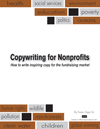Chris Stiner – Search Marketing Standard blog, shared “The Super 7 Reasons to Blog (Aside From Linking)”. Of course, blogging is a significant boost to your SEO results. And it’s also a smart marketing strategy in terms of ROI – lot of bang for your buck. But Stiner goes beyond all that.
For each of his seven “super” reasons I have added the nonprofit perspective:
1. Promote products and services from credible, insider point of view.
Nonprofit: Share why your cause or mission is so important to you, the individual blogger. Share your personal excitement over what your nonprofit is achieving. Use “I” much, much more than “we” or “our” in your writing.
2. Establish authority in the marketplace.
Nonprofit: Stand out as the best. There’s a lot of competition for donor and grant dollars. Show your expertise at solving problems for those you serve. Don’t brag. Talk about the issues and what they mean for society. Share your depth of knowledge on the issues and softly, subtly weave how your nonprofit addresses them.
3. Show a human side to your business. People are loyal to companies that are transparent and real.
Nonprofit: It’s okay – and still professional – to share some of your personality in a blog. Supporters connect with and stick with friendly people so be personable.
Allow comments on your blog. Give donors and members a chance to say why they like what you’re doing. This is transparency. And for prospects you want to convert to supporters, seeing outsider comments gives your nonprofit more credibility. They are more confident in their decision to help you.
In addition, if by chance a “problem” arises within your organization (e.g., a scandal or any negative news about how you do business), talk about how you’re solving it. Bad news travels faster than the speed of sound. Be the pilot openly sharing the status of the problem with your passengers who just might be able to help you. Don’t let the plane crash with your thunderous silence.
4. Communicate with customers even after a purchase.
Nonprofit: Say thank you for donating or joining. Follow-up with a welcome package, renewal mailings, and get them on your newsletter list. Practice great donor/member cultivation strategies. Share success stories about your mission. Give supporters the information they want.
5. Blogs blend well with other social media such as Digg and Twitter.
Nonprofit: You wrote a touching success story in your blog. The plug-ins are there so anyone can Tweet or Digg your post with a mere click or two. Now your supporters and followers are doing the work for you. And when they pass on news about your nonprofit, it’s more credible than if you did it yourself. These easy-to-use tools are great for spreading awareness and for gathering in more supporters from the grassroots level.
6. Discover keyword phrases you rank well for that you never thought of.
Nonprofit: In the normal course of writing a blog, you’ll appear high in organic searches for phrases you couldn’t have foreseen. This is the beauty of blogging and natural search. Think of it as extra frosting on the cake that you didn’t even ask for.
7. Quality blogging can lead to exposure on other blogs and media channels in your industry.
Nonprofit: Your stories, comments, insider expertise … can all start to appear in other blogs, newsletters, etc. like magic. All you did was consistently write quality blog posts. And the visibility just might make it more likely that a journalist will contact you – for your expert perspective – when a news story breaks related to your mission.
No doubt about it: Blogging is a powerful tool offering your nonprofit many benefits. It’s an easy and fast way to keep current news and stories on your website. You need to be personable, and write messages focused on your donors and members. Do this well and supporters will spread the good news for you farther than you ever could on your own.
